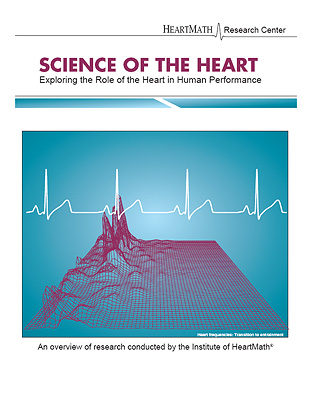Science of the Heart: Vol 1 (1993-2001) Exploring the Role of the Heart in Human Performance
An Overview of Research Conducted by the HeartMath Institute
For centuries, the heart has been considered the source of emotion, courage and wisdom. At the HeartMath Institute Research Center, we are exploring the physiological mechanisms by which the heart communicates with the brain, thereby influencing information processing, perceptions, emotions and health.
We are asking questions such as: Why do people experience the feeling or sensation of love and other positive emotional states in the area of the heart and what are the physiological ramifications of these emotions? How do stress and different emotional states affect the autonomic nervous system, the hormonal and immune systems, the heart and brain?
Over the years we have experimented with different psychological and physiological measures, but it was consistently heart rate variability, or heart rhythms, that stood out as the most dynamic and reflective of inner emotional states and stress. It became clear that negative emotions lead to increased disorder in the heart’s rhythms and in the autonomic nervous system, thereby adversely affecting the rest of the body. In contrast, positive emotions create increased harmony and coherence in heart rhythms and improve balance in the nervous system. The health implications are easy to understand: Disharmony in the nervous system leads to inefficiency and increased stress on the heart and other organs while harmonious rhythms are more efficient and less stressful to the body’s systems.
More intriguing are the dramatic positive changes that occur when techniques are applied that increase coherence in rhythmic patterns of heart rate variability. These include shifts in perception and the ability to reduce stress and deal more effectively with difficult situations. We observed that the heart was acting as though it had a mind of its own and was profoundly influencing the way we perceive and respond to the world. In essence, it appeared that the heart was affecting intelligence and awareness.
The answers to many of our original questions now provide a scientific basis to explain how and why the heart affects mental clarity, creativity, emotional balance and personal effectiveness. Our research and that of others indicate that the heart is far more than a simple pump. The heart is, in fact, a highly complex, self-organized information processing center with its own functional “brain” that communicates with and influences the cranial brain via the nervous system, hormonal system and other pathways. These influences profoundly affect brain function and most of the body’s major organs, and ultimately determine the quality of life.
Science of the Heart: Volume 2 (1993 to 2016) is now available. Click to view or download.
SubscriberSign Up to Read
Sign up for FREE below and you’ll receive access to all of our free Subscriber downloads. In addition, you will receive HMI news, updates on the latest scientific research and more.

